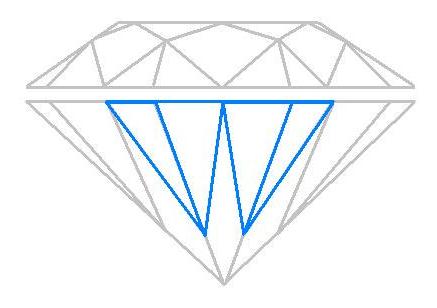The lower-girdle facets are crucial elements in the overall symmetry and brilliance of a diamond. These triangle-shaped facets are located on the pavilion of the diamond, directly adjacent to the girdle, which is the outer edge of the diamond. The pavilion refers to the bottom part of the diamond, below the girdle, which is responsible for reflecting light back through the crown and into the observer’s eye.
Position and Structure
Location: The lower-girdle facets are positioned on the pavilion of the diamond, near the girdle. They are situated just below the main facets of the pavilion, including the main pavilion facets, which are the large, flat surfaces that reflect light into the crown.
Shape: These facets are typically triangle-shaped, although their size and exact proportions can vary depending on the cut of the diamond. In some diamonds, these lower-girdle facets may be slightly elongated or modified, but they usually maintain a triangular form.
Function: The primary function of the lower-girdle facets is to help direct light in the diamond, contributing to its brilliance and scintillation. These facets work by reflecting light that enters the pavilion from below, which then bounces back through the crown of the diamond, creating the visual effects that make diamonds sparkle. The interaction between the light and these facets is essential in maximizing the diamond’s overall visual appeal.
Impact on Diamond Performance
Brilliance:
The brilliance of a diamond is its ability to reflect white light. The lower-girdle facets play an important role in this by directing light from the pavilion back into the crown. When the light is properly reflected, it bounces back to the viewer’s eye, enhancing the diamond’s brightness.
Scintillation:
Scintillation refers to the flashes of light that occur when a diamond moves or is viewed from different angles. The lower-girdle facets help enhance scintillation by creating additional reflections and refractions of light. Their triangular shape and position allow them to catch light from various angles, contributing to the diamond’s overall sparkle.
Symmetry:
Properly aligned and symmetrical lower-girdle facets are essential to the overall symmetry of the diamond. When the facets are evenly proportioned, the diamond will have a more visually appealing appearance, with well-defined light reflections and a balanced sparkle. Any irregularities in the alignment or shape of these facets can lead to an uneven distribution of light, reducing the diamond’s brilliance.
Grading the Lower-Girdle Facets
In diamond grading, the quality of the lower-girdle facets is considered as part of the overall cut grade, which evaluates how well the diamond has been shaped and proportioned to maximize its brilliance, fire, and scintillation. Some of the factors that affect the grading of the lower-girdle facets include:
Size and Proportion:
The size and proportion of the lower-girdle facets should be well balanced with the other facets of the diamond, including the main pavilion facets and the upper girdle facets. Proper proportions contribute to the diamond’s overall symmetry and visual appeal.
Symmetry:
Symmetry is one of the key components of diamond grading. Lower-girdle facets should be symmetrical, with uniform size and placement. Any misalignment or uneven facet sizes can disrupt the flow of light through the diamond and impact its overall performance.
Polish:
A well-polished surface on the lower-girdle facets enhances the diamond’s ability to reflect light. Poor polishing can lead to a dull appearance and reduce the brilliance of the diamond.
Role in Different Diamond Cuts
While lower-girdle facets are typically found in round brilliant cut diamonds, their placement and function can also be seen in other shapes that share similar cutting structures. However, the round brilliant cut diamond relies most heavily on the lower-girdle facets to achieve optimal light performance.
Round Brilliant Cut:
In the round brilliant cut, the lower-girdle facets are particularly important in creating the characteristic sparkle and fire that this cut is known for. The precise arrangement of these facets ensures that the diamond exhibits maximum brilliance and scintillation.
Other Fancy Cuts:
While fancy shapes like emerald, princess, or asscher cuts have different facet structures, they still rely on the principles of light reflection and refraction that are found in the lower-girdle facets of the round brilliant cut. For these shapes, the positioning and number of lower-girdle facets can vary, but their purpose remains the same: to enhance the diamond’s brilliance.
Impact of the Lower-Girdle Facets on Diamond Value
Diamonds with well-proportioned and well-cut lower-girdle facets typically have better light performance, meaning they will display more brilliance, scintillation, and fire. As such, diamonds with ideal or well-graded lower-girdle facets are generally considered more valuable because they are more visually appealing. Poorly proportioned or poorly cut lower-girdle facets can negatively affect the diamond’s performance, reducing its overall desirability and value.
.

